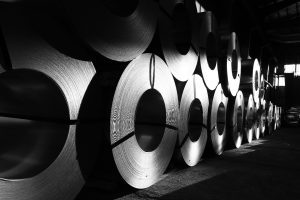
Image by Morteza Mohammadi on Unsplash
Understanding the UK CBAM and its role in reducing embodied carbon emissions
Supply chain emissions are creeping up sustainability agendas and there is new legislation that promises to help. The UK’s Carbon Border Adjustment Mechanism (CBAM) [1][2], due to be implemented from 2027, is a policy aimed at reducing carbon emissions by imposing tariffs on imported goods that do not meet the UK’s environmental standards. As a critical component in the fight against climate change, CBAM targets the reduction of embodied carbon emissions – those emissions produced during the manufacturing and transportation of building materials.
What is the UK CBAM?
The CBAM is designed to level the playing field for domestic producers and encourage global carbon reduction efforts. By applying a carbon tariff on imports such as steel, iron, aluminium and cement – key materials in the construction industry – it aims to prevent carbon leakage. Carbon leakage occurs when companies relocate production to countries with lax emission regulations, thereby undermining global climate initiatives.
Here’s the advantages spelled out in the policy:
- Increased costs of high-carbon materials:
One immediate effect of the CBAM is the increased cost of imported building materials with high embodied carbon. This price hike will incentivise the construction industry to seek out and utilise materials that are produced with lower carbon footprints, thus reducing overall embodied carbon emissions. The higher tariffs make sustainable materials more financially attractive, driving innovation and adoption in green construction practices.
- Promotion of sustainable building practices:
By making high-carbon materials more expensive, the CBAM encourages the industry to adopt more sustainable building practices. This includes using alternative materials such as recycled steel and low-carbon concrete. These practices not only reduce embodied carbon emissions but also contribute to the overall sustainability and energy efficiency of buildings.
- Encouragement of local sourcing:
The CBAM promotes the local sourcing of building materials, as domestic products are often subject to more stringent environmental regulations. By reducing reliance on imported materials with high embodied carbon, the policy supports local economies and reduces emissions associated with long-distance transportation. This shift to local sourcing can significantly cut down the embodied carbon in construction projects.
- Innovation in material production:
The financial impact of the CBAM will drive manufacturers to innovate and develop low-carbon production technologies. This could lead to advancements in the production processes of steel, cement, and aluminium, resulting in lower embodied carbon emissions. Companies may invest in carbon capture and storage technologies, use renewable energy in manufacturing, and improve energy efficiency across production lines.
- Increased transparency and accountability:
The CBAM necessitates greater transparency and accountability in the supply chain. Manufacturers and suppliers will be required to disclose their carbon emissions, leading to more informed choices by builders and developers. This increased transparency helps in tracking and reducing embodied carbon emissions, fostering a more environmentally conscious construction industry.
- Impact on supply chain dynamics:
The introduction of CBAM will reshape supply chain dynamics, with construction companies opting for suppliers who demonstrate lower embodied carbon emissions. This will encourage a more rigorous assessment of supply chains and foster partnerships with eco-friendly manufacturers. Over time, the construction industry will develop more sustainable supply chains, contributing to substantial reductions in embodied carbon emissions.
- Focus on scope 1, 2, and 3 emissions:
The CBAM will drive a comprehensive approach to managing greenhouse gas emissions across all scopes:
– Scope 1 emissions: Direct emissions from manufacturing processes. Companies will need to reduce these through improved energy efficiency and cleaner production technologies.
– Scope 2 emissions: Indirect emissions from the generation of purchased electricity, steam, heating, and cooling. Shifting to renewable energy sources can help reduce these emissions.
– Scope 3 emissions: All other indirect emissions, including those from the supply chain and transportation of materials. Whilst scope 3 emissions aren’t in the initial remit of CBAM, they are likely to be included in the future. This will incentivise companies to assess and reduce these emissions, encouraging a holistic approach to carbon management.
By addressing emissions across these categories, the construction industry can significantly lower embodied carbon emissions, aligning with national and global carbon reduction targets. This approach will enhance the industry’s reputation as a leader in sustainability, attract environmentally conscious clients and investors, and unlock funding opportunities aimed at promoting green building practices.
The UK CBAM is a transformative policy that aims to drive substantial reductions in embodied carbon emissions. By increasing the cost of high-carbon materials and promoting sustainable practices, it not only supports the UK’s climate goals but also stimulates innovation and transparency in the construction industry. As the sector adapts to these changes, it will play a crucial role in advancing both national and global environmental objectives and fostering a more sustainable future.
If you would like to evaluate the embodied carbon emissions in your supply chain, please be in touch: https://shiftenvironment.co.uk/contact/
[1] Factsheet: UK Carbon Border Adjustment Mechanism – GOV.UK (www.gov.uk)
